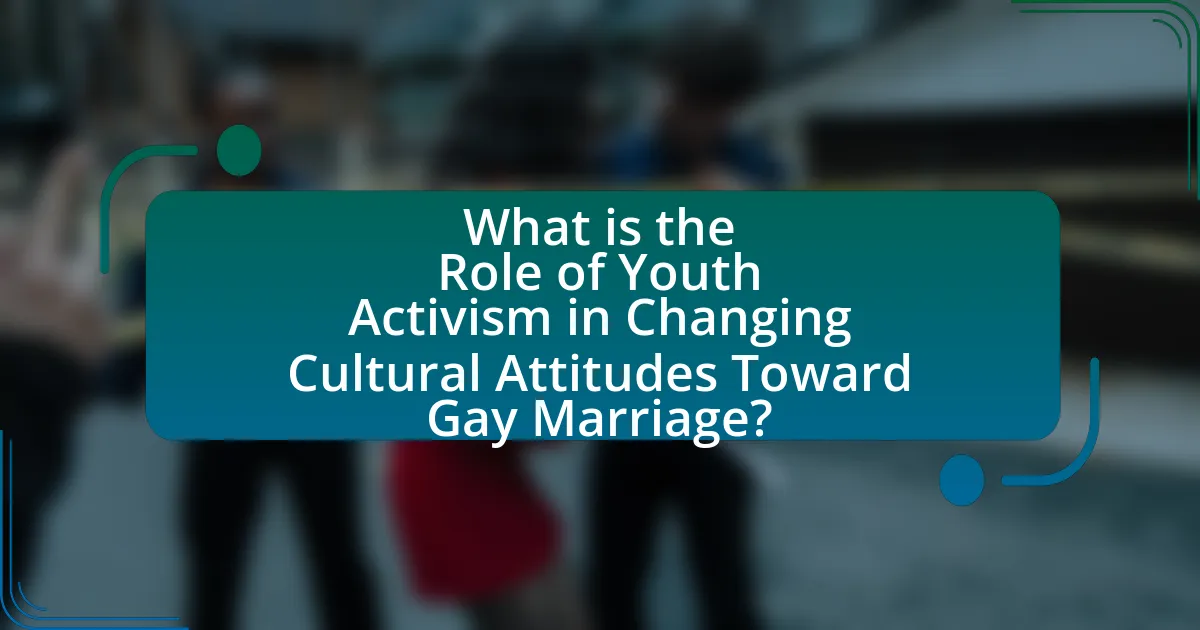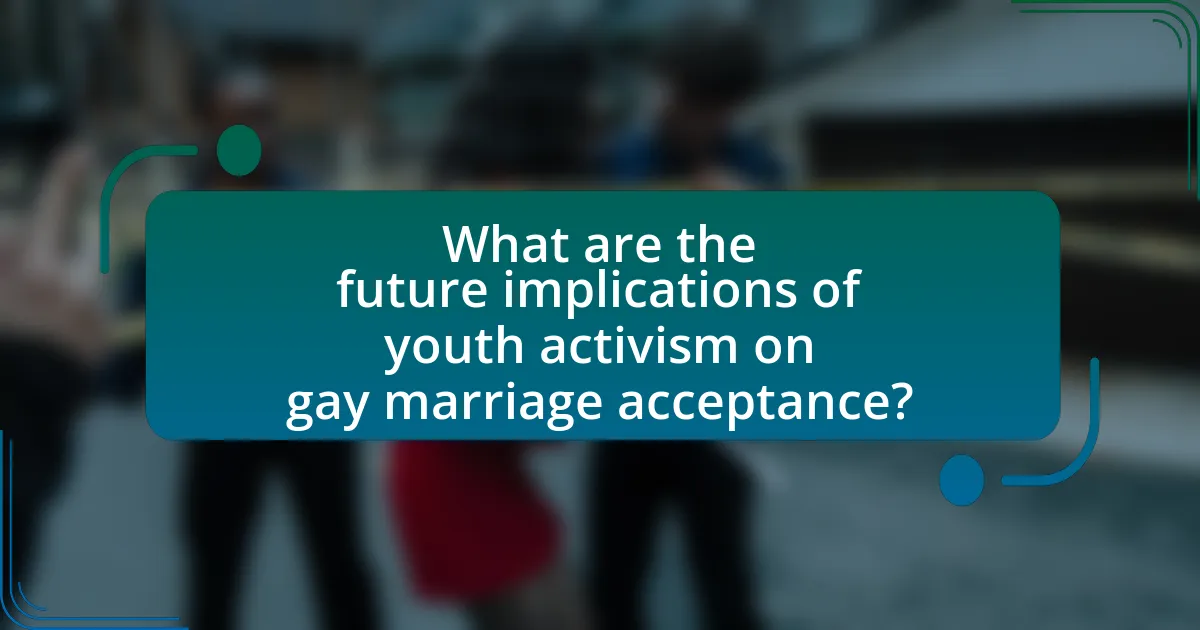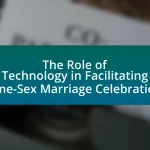Youth activism plays a pivotal role in transforming cultural attitudes toward gay marriage by mobilizing support, raising awareness, and influencing public opinion. The article examines the historical impact of youth-led movements, highlighting key events such as the “It Gets Better” campaign and the Obergefell v. Hodges Supreme Court ruling, which have significantly shaped perceptions of LGBTQ+ rights. It also discusses the effectiveness of social media in amplifying youth voices, the challenges faced by activists, and the importance of personal narratives in fostering empathy and understanding. Furthermore, the article explores the potential future implications of ongoing youth activism on legal outcomes and societal acceptance of gay marriage.

What is the Role of Youth Activism in Changing Cultural Attitudes Toward Gay Marriage?
Youth activism plays a crucial role in changing cultural attitudes toward gay marriage by mobilizing support, raising awareness, and influencing public opinion. Young activists utilize social media platforms to disseminate information, share personal stories, and foster community engagement, which has been shown to shift perceptions significantly. For instance, a study by the Williams Institute found that increased visibility of LGBTQ+ issues among youth correlates with greater acceptance of gay marriage, highlighting the impact of youth-led initiatives in promoting equality. Additionally, youth activism often intersects with broader social movements, amplifying calls for justice and inclusion, thereby reshaping cultural narratives around marriage equality.
How has youth activism historically influenced cultural attitudes?
Youth activism has historically influenced cultural attitudes by challenging societal norms and advocating for progressive changes, particularly in the context of civil rights and social justice movements. For instance, during the 1960s, youth-led protests against racial segregation and the Vietnam War significantly shifted public perceptions and policies, laying the groundwork for future movements, including those advocating for LGBTQ+ rights. The Stonewall Riots of 1969, driven by young activists, catalyzed the modern LGBTQ+ rights movement, leading to increased visibility and acceptance of gay marriage. Research indicates that younger generations are more supportive of LGBTQ+ rights, with a 2020 Gallup poll showing that 63% of Americans aged 18-29 support same-sex marriage, reflecting the long-term impact of youth activism on cultural attitudes.
What key events marked the rise of youth activism in this context?
Key events that marked the rise of youth activism in changing cultural attitudes toward gay marriage include the 2011 “It Gets Better” campaign, which mobilized young people to share personal stories of overcoming bullying and discrimination, and the 2015 Supreme Court ruling in Obergefell v. Hodges, which legalized same-sex marriage nationwide. The “It Gets Better” campaign garnered significant attention and support from youth, leading to increased visibility and acceptance of LGBTQ+ issues. The Obergefell decision was a pivotal moment that solidified the legal recognition of same-sex marriage, reflecting the influence of youth activism in shaping public opinion and policy.
How do social movements led by youth shape public perception?
Social movements led by youth significantly shape public perception by mobilizing collective action and leveraging social media to amplify their messages. For instance, the 2015 Supreme Court ruling in favor of same-sex marriage in the United States was influenced by youth-led movements that advocated for LGBTQ+ rights, demonstrating a shift in societal attitudes. Research from the Pew Research Center indicates that younger generations are more supportive of gay marriage compared to older demographics, highlighting how youth activism can alter cultural norms and influence legislative outcomes.
Why is youth activism particularly effective in advocating for gay marriage?
Youth activism is particularly effective in advocating for gay marriage because it harnesses the energy, creativity, and social media savvy of younger generations to mobilize support and challenge traditional norms. This demographic often prioritizes equality and inclusivity, making them more likely to engage in advocacy efforts that resonate with their values. For instance, studies show that younger individuals are more accepting of LGBTQ+ rights, with a 2020 Gallup poll indicating that 63% of adults aged 18-29 support same-sex marriage, compared to 45% of those aged 50 and older. Additionally, youth-led movements utilize platforms like Instagram and TikTok to spread awareness and foster community, amplifying their message and reaching a broader audience quickly. This combination of passion, demographic alignment with progressive values, and effective use of technology makes youth activism a powerful force in the fight for gay marriage.
What unique perspectives do young activists bring to the conversation?
Young activists bring fresh, innovative perspectives to the conversation about gay marriage, emphasizing inclusivity and intersectionality. Their experiences often reflect a more diverse understanding of identity, as they advocate for the rights of not only LGBTQ+ individuals but also marginalized communities affected by systemic inequalities. For instance, studies show that younger generations are more likely to support same-sex marriage, with a 2021 Gallup poll indicating that 70% of adults aged 18-29 favor it, compared to 45% of those aged 50 and older. This generational shift highlights how young activists challenge traditional norms and push for broader acceptance and legal recognition of diverse relationships.
How does social media amplify the voices of youth activists?
Social media amplifies the voices of youth activists by providing a platform for widespread communication and engagement. Through platforms like Twitter, Instagram, and TikTok, young activists can share their messages, mobilize support, and connect with like-minded individuals globally. For instance, the #LoveIsLove campaign gained significant traction on social media, allowing youth to advocate for gay marriage rights and challenge cultural attitudes. This digital reach enables activists to bypass traditional media gatekeepers, ensuring their perspectives are heard and fostering community support, as evidenced by the rapid spread of information during events like Pride Month.
What challenges do youth activists face in promoting gay marriage?
Youth activists face significant challenges in promoting gay marriage, including societal stigma, legal barriers, and limited resources. Societal stigma manifests as discrimination and negative perceptions from various communities, which can hinder open discussions and acceptance of gay marriage. Legal barriers include varying state laws and regulations that restrict marriage equality, making it difficult for activists to advocate effectively. Additionally, limited resources such as funding, access to platforms for advocacy, and support networks can impede their efforts to mobilize and educate the public. These challenges collectively impact the effectiveness of youth activism in advancing the cause of gay marriage.
What societal barriers hinder youth activism efforts?
Societal barriers that hinder youth activism efforts include lack of access to resources, generational divides, and institutional resistance. Limited financial support and educational resources restrict youth from effectively organizing and mobilizing. Additionally, older generations may not fully understand or support youth-led initiatives, creating a disconnect that can stifle collaboration. Institutional resistance, such as policies that limit youth participation in decision-making processes, further complicates activism efforts. For instance, a study by the National Youth Rights Association highlights that youth often face legal and bureaucratic obstacles that prevent them from engaging in activism, demonstrating the systemic challenges they encounter.
How do legal and political obstacles impact youth-led initiatives?
Legal and political obstacles significantly hinder youth-led initiatives by restricting their ability to mobilize, advocate, and implement change effectively. For instance, laws that limit freedom of assembly or expression can prevent young activists from organizing protests or campaigns, thereby stifling their voices. Additionally, political resistance from established authorities can lead to a lack of support for initiatives aimed at promoting LGBTQ+ rights, as seen in various regions where youth-led movements have faced pushback from local governments. This resistance can manifest in the form of legal challenges, funding restrictions, or outright hostility, which ultimately undermines the impact and reach of youth activism in changing cultural attitudes toward gay marriage.

How do cultural attitudes toward gay marriage evolve through youth activism?
Cultural attitudes toward gay marriage evolve through youth activism by fostering awareness, challenging societal norms, and mobilizing support for LGBTQ+ rights. Youth activism, exemplified by movements such as the 2015 “Love is Love” campaign, has significantly influenced public perception by utilizing social media platforms to spread messages of equality and acceptance. Research indicates that younger generations, who are more engaged in activism, tend to support gay marriage at higher rates; for instance, a 2020 Gallup poll showed that 83% of adults aged 18-29 favored legalizing same-sex marriage. This generational shift reflects the impact of youth-led initiatives that promote inclusivity and challenge discriminatory attitudes, ultimately leading to broader societal acceptance of gay marriage.
What strategies do youth activists employ to change cultural attitudes?
Youth activists employ strategies such as social media campaigns, grassroots organizing, and educational initiatives to change cultural attitudes. Social media campaigns leverage platforms like Instagram and Twitter to spread awareness and foster dialogue about gay marriage, reaching a broad audience quickly. Grassroots organizing involves mobilizing local communities to participate in events, protests, and discussions, creating a sense of solidarity and urgency around the issue. Educational initiatives aim to inform peers and the public about LGBTQ+ rights and the importance of marriage equality, often through workshops, seminars, and informational resources. These strategies have been effective in shifting public perception, as evidenced by increasing support for gay marriage in various demographics over the past decade.
How do educational campaigns contribute to shifting perceptions?
Educational campaigns contribute to shifting perceptions by providing accurate information and fostering dialogue around social issues, such as gay marriage. These campaigns often utilize various media platforms to reach diverse audiences, effectively challenging stereotypes and misconceptions. For instance, studies have shown that educational initiatives, like those conducted by organizations advocating for LGBTQ+ rights, have led to increased acceptance of gay marriage among young people. According to a 2019 survey by the Pew Research Center, 70% of millennials support same-sex marriage, a significant increase from previous generations, highlighting the impact of sustained educational efforts.
What role do public demonstrations play in influencing cultural norms?
Public demonstrations play a crucial role in influencing cultural norms by providing a visible platform for collective expression and advocacy. These events mobilize individuals around shared values and issues, often leading to increased awareness and dialogue within society. For instance, the Stonewall Riots in 1969 catalyzed the LGBTQ+ rights movement, significantly shifting public perceptions and cultural attitudes toward gay marriage. Research indicates that sustained public demonstrations can lead to legislative changes and greater acceptance, as seen in various countries where protests have successfully advocated for marriage equality.
How do personal stories from youth activists impact cultural change?
Personal stories from youth activists significantly impact cultural change by humanizing issues and fostering empathy among diverse audiences. These narratives often illustrate the personal struggles and triumphs related to social justice, making abstract concepts more relatable. For instance, the experiences shared by youth activists during campaigns for gay marriage have been shown to shift public opinion; a study by the Williams Institute found that personal connections to LGBTQ+ individuals increased support for marriage equality by 20%. This demonstrates that storytelling not only raises awareness but also catalyzes shifts in societal attitudes, ultimately contributing to broader cultural acceptance and policy changes.
What is the significance of storytelling in advocacy efforts?
Storytelling is significant in advocacy efforts because it humanizes issues and fosters emotional connections, making complex topics more relatable. In the context of youth activism for gay marriage, personal narratives can illustrate the real-life impact of policies, thereby influencing public opinion and policy change. Research indicates that stories can increase empathy and understanding, as demonstrated in a study by the University of California, which found that narratives about marginalized groups can shift attitudes and promote social change. By sharing experiences, advocates can effectively mobilize support and challenge cultural attitudes, ultimately contributing to the acceptance of gay marriage.
How do personal narratives resonate with broader audiences?
Personal narratives resonate with broader audiences by fostering empathy and relatability, allowing individuals to connect emotionally with experiences that may differ from their own. This connection is particularly evident in the context of youth activism for gay marriage, where personal stories highlight the struggles and triumphs of LGBTQ+ individuals, making abstract issues more tangible. Research indicates that narratives can significantly influence public opinion; for instance, a study by the American Psychological Association found that personal stories can shift attitudes by 30% or more when they evoke emotional responses. This demonstrates that personal narratives serve as powerful tools for advocacy, bridging gaps between diverse experiences and promoting understanding within society.
What role do allies play in supporting youth activism for gay marriage?
Allies play a crucial role in supporting youth activism for gay marriage by amplifying voices, providing resources, and fostering inclusive environments. Their support helps to legitimize the activism efforts of youth, as allies often have access to platforms and networks that can increase visibility for the cause. For instance, research from the Williams Institute indicates that public support from allies can significantly influence public opinion and policy changes regarding LGBTQ+ rights. Additionally, allies can offer mentorship and guidance, helping young activists navigate challenges and develop effective strategies for advocacy. This collaborative effort enhances the overall impact of youth activism in promoting acceptance and legal recognition of gay marriage.
How can adults and organizations collaborate with youth activists?
Adults and organizations can collaborate with youth activists by providing mentorship, resources, and platforms for their voices. This collaboration can take the form of workshops where experienced adults share knowledge on advocacy strategies, legal frameworks, and effective communication. Organizations can also offer funding or logistical support for youth-led initiatives, ensuring that young activists have the necessary tools to mobilize their communities. For instance, partnerships between established NGOs and youth groups have successfully amplified campaigns for social change, as seen in various movements advocating for LGBTQ+ rights, where youth activism has played a pivotal role in shifting public opinion on gay marriage.
What impact do intergenerational partnerships have on advocacy?
Intergenerational partnerships significantly enhance advocacy by combining diverse perspectives and experiences, which leads to more comprehensive and effective strategies. These collaborations allow younger activists to leverage the wisdom and historical context provided by older generations, while older advocates benefit from the innovative approaches and energy of youth. Research indicates that such partnerships can increase the reach and impact of advocacy efforts, as seen in movements for social justice and equality, where cross-generational alliances have successfully mobilized broader support and fostered inclusive dialogue. For instance, the collaboration between youth-led organizations and established civil rights groups has been pivotal in advancing LGBTQ+ rights, demonstrating that intergenerational partnerships can amplify voices and drive meaningful change in cultural attitudes toward issues like gay marriage.

What are the future implications of youth activism on gay marriage acceptance?
Youth activism will significantly enhance the acceptance of gay marriage in the future by fostering progressive cultural shifts and influencing policy changes. As younger generations increasingly advocate for LGBTQ+ rights, their efforts are reflected in public opinion trends; for instance, a 2021 Gallup poll indicated that 70% of Americans aged 18-29 support same-sex marriage, compared to 45% of those aged 50 and older. This generational divide suggests that as youth activism continues to grow, it will likely lead to broader societal acceptance and legal recognition of gay marriage. Furthermore, youth-led movements often utilize social media to amplify their messages, creating a more connected and informed populace that is more likely to support LGBTQ+ rights.
How might ongoing youth activism shape future legal outcomes for gay marriage?
Ongoing youth activism is likely to significantly influence future legal outcomes for gay marriage by fostering a more inclusive cultural environment that prioritizes equality. This activism, characterized by organized campaigns, social media engagement, and public demonstrations, has already shifted public opinion; for instance, a 2021 Gallup poll indicated that 70% of Americans support same-sex marriage, a figure that has risen dramatically over the past two decades, largely due to the efforts of younger generations. As youth continue to advocate for LGBTQ+ rights, they create pressure on lawmakers to align legal frameworks with evolving societal values, potentially leading to more favorable rulings and legislation regarding gay marriage.
What trends indicate the potential for further cultural shifts?
Trends indicating the potential for further cultural shifts include the increasing visibility and acceptance of LGBTQ+ rights among younger generations. Surveys show that 70% of millennials and Gen Z support same-sex marriage, reflecting a significant change in societal attitudes compared to older generations. Additionally, youth-led movements, such as Pride events and social media campaigns, amplify awareness and advocacy for LGBTQ+ issues, fostering a culture of inclusivity. The rise of digital platforms enables rapid dissemination of information and mobilization, further driving cultural change. These factors collectively suggest a trajectory toward greater acceptance and normalization of diverse sexual orientations and relationships.
How can youth activism influence policy changes in the long term?
Youth activism can influence policy changes in the long term by mobilizing public opinion and creating sustained pressure on lawmakers. For instance, movements led by young activists, such as the fight for marriage equality, have successfully shifted societal attitudes, leading to significant legislative changes like the legalization of same-sex marriage in various countries. Research indicates that youth-led campaigns often utilize social media to amplify their messages, engage peers, and foster community support, which can result in increased voter turnout and advocacy for policy reform. The impact of youth activism is evidenced by the 2015 U.S. Supreme Court ruling in Obergefell v. Hodges, which legalized same-sex marriage nationwide, reflecting the changing cultural attitudes largely driven by younger generations advocating for equality.
What best practices can youth activists adopt to enhance their impact?
Youth activists can enhance their impact by leveraging social media platforms to amplify their messages and engage with a broader audience. Research indicates that social media campaigns can significantly increase awareness and support for social issues; for instance, the #LoveWins campaign played a crucial role in shifting public opinion on gay marriage in the United States, contributing to the Supreme Court’s decision in 2015 to legalize it nationwide. Additionally, youth activists should collaborate with established organizations to gain resources and credibility, as partnerships can enhance outreach and effectiveness. Engaging in grassroots organizing and community education initiatives also fosters local support and mobilizes action, which has been shown to be effective in various social movements.
How can effective communication strategies improve outreach?
Effective communication strategies can significantly enhance outreach by ensuring that messages resonate with target audiences. When youth activists utilize clear, relatable language and culturally relevant references, they can engage peers more effectively, fostering a sense of community and shared purpose. Research indicates that campaigns employing storytelling and personal narratives can increase emotional connection, leading to higher engagement rates. For instance, a study by the Pew Research Center found that 70% of young people are more likely to support causes when they feel personally connected to the stories shared. This demonstrates that effective communication not only conveys information but also builds relationships, ultimately improving outreach efforts in the context of youth activism for gay marriage.
What role does community engagement play in successful activism?
Community engagement is crucial for successful activism as it fosters collective action and amplifies voices within a movement. Engaged communities create a support network that enhances the visibility and impact of activism efforts, leading to greater public awareness and policy change. For instance, the Human Rights Campaign’s initiatives to promote gay marriage gained momentum through grassroots mobilization, demonstrating that community involvement can significantly influence cultural attitudes and legislative outcomes. Studies show that movements with strong community ties are more effective in achieving their goals, as they leverage local knowledge and resources to drive change.


